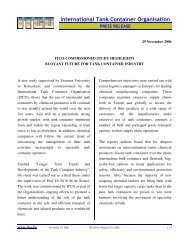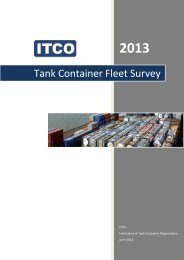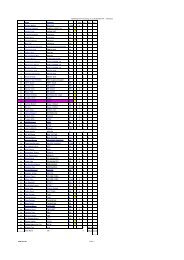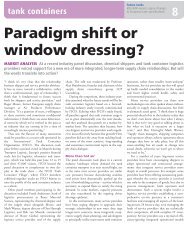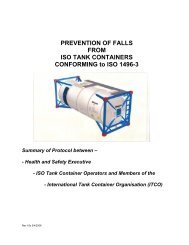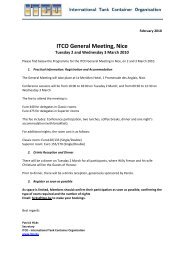Create successful ePaper yourself
Turn your PDF publications into a flip-book with our unique Google optimized e-Paper software.
ICHCA International <strong>Safe</strong>ty Panel Briefing Pamphlet No 30<br />
5.3.4.2 The most common type <strong>of</strong> airline valve fitted to tank containers is the ball<br />
valve (see Picture 22). Picture 23 shows a less common butterfly airline<br />
valve. However there are a large number <strong>of</strong> other valves used such as fire<br />
safe, plug valves, quick coupling assemblies, etc. One or more <strong>of</strong> the valves<br />
may be fitted with a pressure gauge. This gauge should not be confused<br />
with the pressure gauge associated with, and fitted to, pressure relief valves<br />
(see section 5.3.2).<br />
Picture 22 Picture 23 Picture 24<br />
5.3.4.3 Picture 24 shows a cluster <strong>of</strong> three ball type vapour valves with a small<br />
pressure gauge; each is capped with a blanking / closing plate.<br />
5.3.4.4 Vapour valves can vary in size from 1½” (38 mm) to 3” (75 mm).<br />
5.3.5 Top Discharge / Outlets<br />
5.3.5.1 Dangerous cargoes which may only be carried in tank containers complying<br />
with portable tank instructions T5, T8, T9, T10, T13, T14 and T19 to T22 can<br />
only be discharged from the top. To provide flexibility in use during their<br />
service life, many tank containers are built to cater for both means <strong>of</strong><br />
discharge, <strong>of</strong>ten with a bottom outlet and the provision for top discharge;<br />
effectively a pad attached to the pressure vessel and a blanking plate. For<br />
cargoes requiring top discharge, tank containers fitted with bottom discharge<br />
openings must have the bottom outlet valves removed and the openings<br />
blanked <strong>of</strong>f by welding inside and out.<br />
5.3.5.2 Conversion <strong>of</strong> bottom outlet tanks (see section 5.4.1) to top discharge is<br />
permitted by the dangerous goods regulations. However, many tank<br />
containers intended for the transport <strong>of</strong> these dangerous goods will be<br />
manufactured from the outset without any bottom openings. Often they are<br />
“dedicated” to just one dangerous good throughout their service life.<br />
5.3.5.3 Rarely some tank containers may retain both their bottom discharge facility<br />
and have top discharge possibilities. This is usually because although the<br />
use <strong>of</strong> bottom discharge tank containers is allowed, customer preference<br />
may be to carry out top discharge operations.<br />
5.3.5.4 Outwardly it is difficult to identify containers with top outlet / discharge. The<br />
bottom discharge opening, if originally fitted, will be blanked over and a<br />
valve will be fitted over the top opening. There may be a sump pot in the<br />
bottom <strong>of</strong> the shell directly under the top outlet but this will only be visible on<br />
non insulated tanks.<br />
5.3.5.5 In practice a top outlet assembly consists <strong>of</strong> at least three valves with<br />
blanking plates. One <strong>of</strong> the valves is located over the top <strong>of</strong> a “siphon tube”<br />
(sometimes called a “dip tube”, “dip pipe”, “siphon pipe”) – see the valve on<br />
the left in Picture 24. This is a vertical pipe, typically <strong>of</strong> 2 inches to 3 inches<br />
/40 mm to 75 mm in diameter which extends from the top <strong>of</strong> the shell<br />
Page 12 ©ICHCA International Limited



